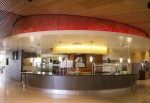Not all swipes are created equal.
One meal plan swipe can provide you with an all-you-can-eat buffet complete with an array of entrees, ice cream, various pastries and drinks.
Or it could buy you a yogurt parfait.
Freshmen are often left perplexed by the fact that items like smoothies and ice cream cones at Bruin Café cost them as much as the kale-covered delicacies offered by Bruin Plate.
Students pay a good deal above cost for each meal, regardless of how they spend their swipes. To make the number of swipes a student spends on a given meal or snack more proportional to its value, we need swipe inflation.
The word “inflation” doesn’t usually carry positive connotations, but a system that treats items of significantly different values uniformly fails to be accessible. If UCLA Dining Services doubled the number of swipes in each meal plan and the price of entry for dining halls and full meals like Bruin Café sandwiches, while small items like gelato stayed at one swipe each, Bruins would get more bang for their buck.
Recent data shows that the average cost per plate at Bruin Plate, the most high-end dining hall, is about $3.90, while takeout restaurants, such as Rendezvous and Café 1919, average about $1.99 per plate. This value gap is permissible, however, compared to the gap between these meals and small ticket items. A large coffee and pastry at Bruin Cafe cost students $2.25 if they decide to pay through Easy Pay, while the typical dinner swipe at any dining hall costs $10 for residents.
Other schools have systems where students can either spend actual dollars or a fake currency that reflects the differing value of dining hall buffets and snacks. Such a system would be difficult to adapt at UCLA, where the swipe system exists to simplify residents’ access to food. The fact that maximizing a meal plan’s value depends on residents choosing to regularly eat full meals without diversifying their diet through lesser-valued snacks indicates, however, that swipes oversimplify students’ consumption.
Standardizing the value of a single swipe and diversifying the meal prices accordingly eliminates the need to parse residents’ meal plans into dollars and cents while still ensuring that students don’t have to sacrifice a meal in the name of a smoothie.
Many students who no longer have regular access to UCLA’s highly ranked residential restaurants look back on their freshman years and long for the halcyon days of endless pasta, salad bars and copious amounts of sugary cereal. It’s difficult to put a price tag on the joy all-you-can-eat food brings to a college student, but it’s definitely not worth the same as a cup of fruit.
